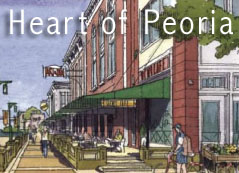Jennifer Davis reports in a front-page story today that the city can’t use their fancy new electronic voting machines for the council primary and election because they can’t handle so-called “bullet voting”:
The new electronic voting machines that the city spent millions on last year can’t count cumulative votes at the precincts, which is required by state law.
Peoria has a rather unique style of cumulative voting that only occurs every four years during at-large council elections. Voters can give all five votes to one candidate; or one each to five; or some combination in between. Some say it is that so-called “bullet provision” which makes our cumulative voting unlike any other nationwide.
Before the city and county went to electronic voting machines, they used a paper ballot which was counted with optical scan equipment. The difference between the county and the city, however, was that the county counted the votes at the precinct level — that is, they had counting machines at each polling place — whereas the city took all the ballots to the main election office and counted them all centrally. The Help America Vote Act (HAVA) requires that votes be counted at the precinct level, not centrally.
So, the question I have (and I haven’t called anyone to ask) is what happened to the machines the county used to use? Did they sell them? If they still have them, are they capable of counting cumulative votes? If so, could the city borrow them for their city council election, if there are enough to cover all the polling places?
I just wonder if this is a case where the city’s cooperation with the county would help, instead of having to go to the state to get special legislation passed.
I also wonder why this is just being discovered now, mere months before the city council election. Who dropped the ball on that one? One would think the election commission would have had the ability to count cumulative votes as a basic requirement of any new voting machine they considered; even if they couldn’t find any machines that offered that functionality, why was no back-up plan put in place? Now, all their hopes are pinned on passing emergency legislation.

 My last post has triggered some very interesting comments and excellent suggestions for Peoria. As a Heart of Peoria Commissioner, I’d like to invite everyone who commented and anyone else with an interest in the new Land Development Code (LDC) for the Heart of Peoria area to attend the public hearing which begins tonight.
My last post has triggered some very interesting comments and excellent suggestions for Peoria. As a Heart of Peoria Commissioner, I’d like to invite everyone who commented and anyone else with an interest in the new Land Development Code (LDC) for the Heart of Peoria area to attend the public hearing which begins tonight.